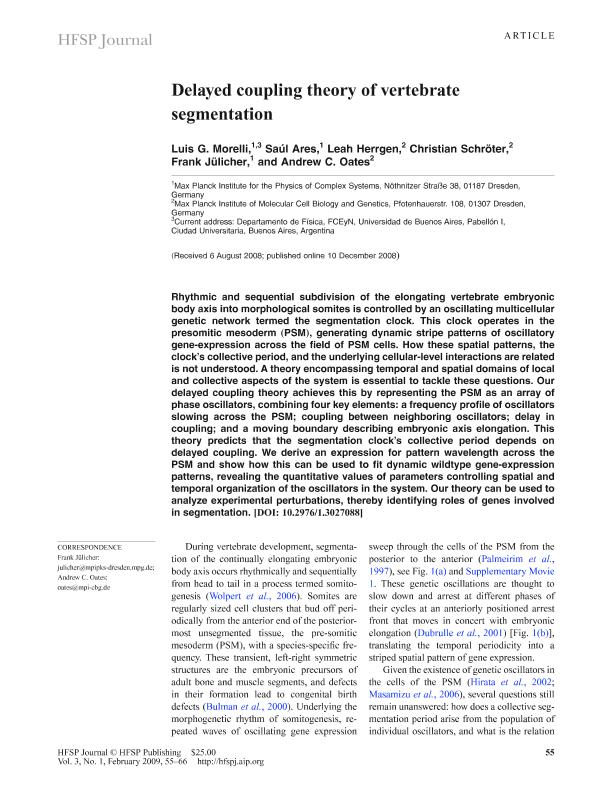Artículo
Delayed coupling theory of vertebrate segmentation
Morelli, Luis Guillermo ; Ares, Saúl; Herrgen, Leah; Schröter, Christian; Jülicher, Frank; Oates, Andrew C.
; Ares, Saúl; Herrgen, Leah; Schröter, Christian; Jülicher, Frank; Oates, Andrew C.
 ; Ares, Saúl; Herrgen, Leah; Schröter, Christian; Jülicher, Frank; Oates, Andrew C.
; Ares, Saúl; Herrgen, Leah; Schröter, Christian; Jülicher, Frank; Oates, Andrew C.
Fecha de publicación:
12/2009
Editorial:
Hfsp Publishing
Revista:
Hfsp Journal
ISSN:
1955-2068
Idioma:
Inglés
Tipo de recurso:
Artículo publicado
Clasificación temática:
Resumen
Rhythmic and sequential subdivision of the elongating vertebrate embryonic body axis into morphological somites is controlled by an oscillating multicellular genetic network termed the segmentation clock. This clock operates in the presomitic mesoderm (PSM), generating dynamic stripe patterns of oscillatory gene-expression across the field of PSM cells. How these spatial patterns, the clock's collective period, and the underlying cellular-level interactions are related is not understood. A theory encompassing temporal and spatial domains of local and collective aspects of the system is essential to tackle these questions. Our delayed coupling theory achieves this by representing the PSM as an array of phase oscillators, combining four key elements: a frequency profile of oscillators slowing across the PSM; coupling between neighboring oscillators; delay in coupling; and a moving boundary describing embryonic axis elongation. This theory predicts that the segmentation clock's collective period depends on delayed coupling. We derive an expression for pattern wavelength across the PSM and show how this can be used to fit dynamic wildtype gene-expression patterns, revealing the quantitative values of parameters controlling spatial and temporal organization of the oscillators in the system. Our theory can be used to analyze experimental perturbations, thereby identifying roles of genes involved in segmentation. © HFSP Publishing.
Palabras clave:
Vertebrate Segmentation
,
Coupled Oscillators
,
Coupling Delays
Archivos asociados
Licencia
Identificadores
Colecciones
Articulos(IFIBA)
Articulos de INST.DE FISICA DE BUENOS AIRES
Articulos de INST.DE FISICA DE BUENOS AIRES
Citación
Morelli, Luis Guillermo; Ares, Saúl; Herrgen, Leah; Schröter, Christian; Jülicher, Frank; et al.; Delayed coupling theory of vertebrate segmentation; Hfsp Publishing; Hfsp Journal; 3; 1; 12-2009; 55-66
Compartir
Altmétricas



